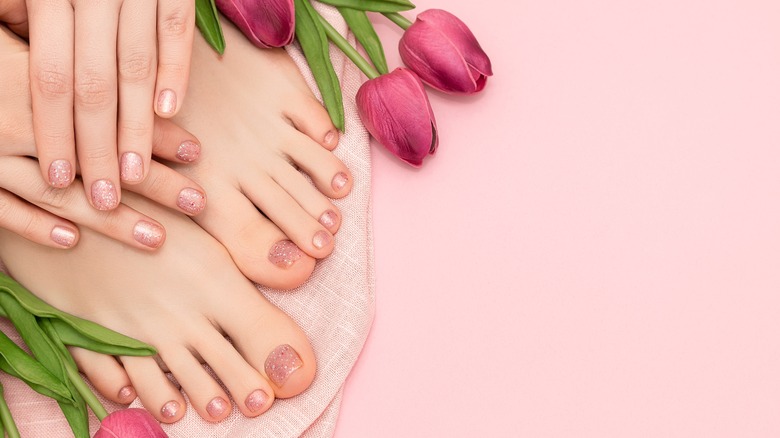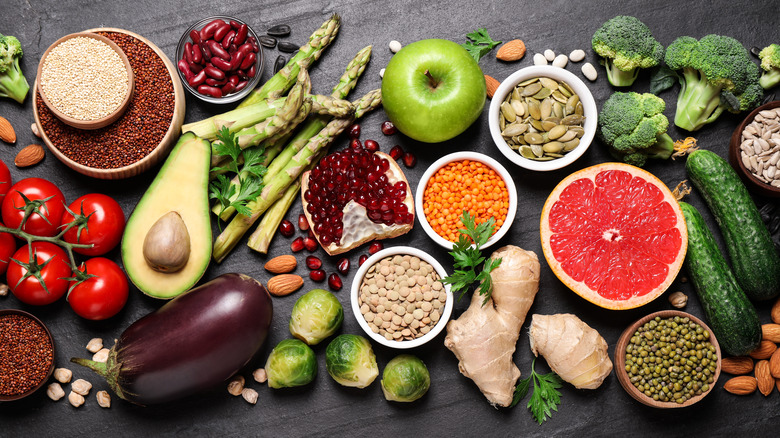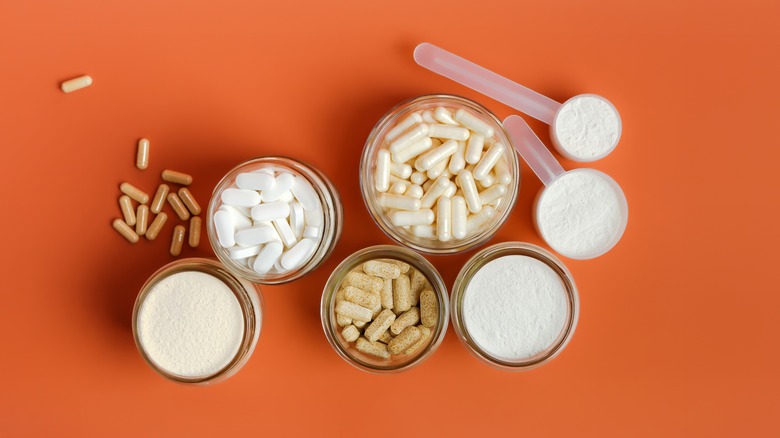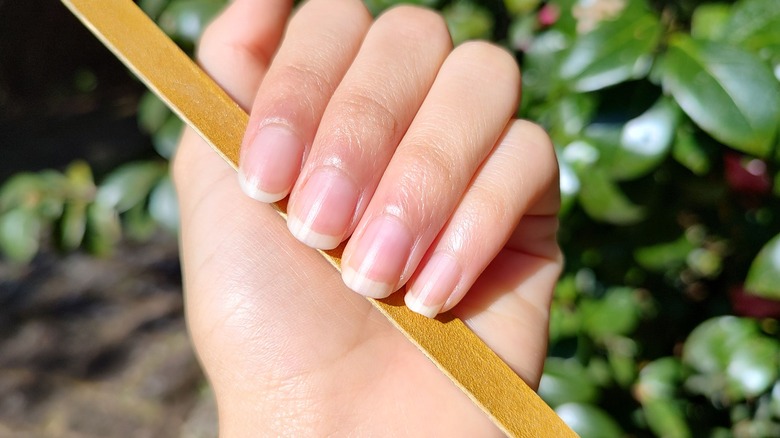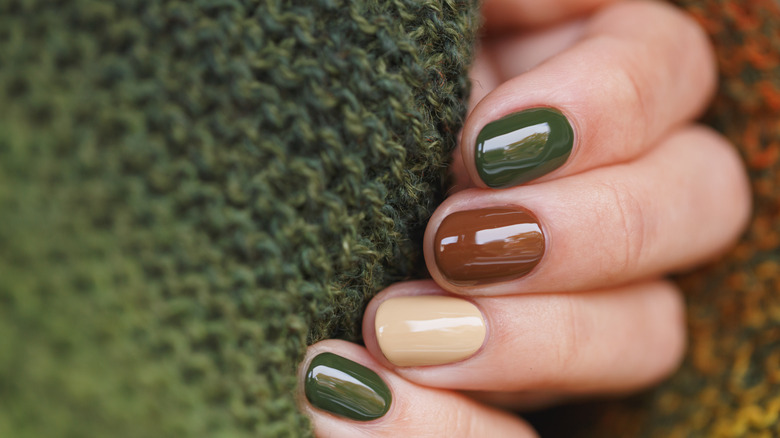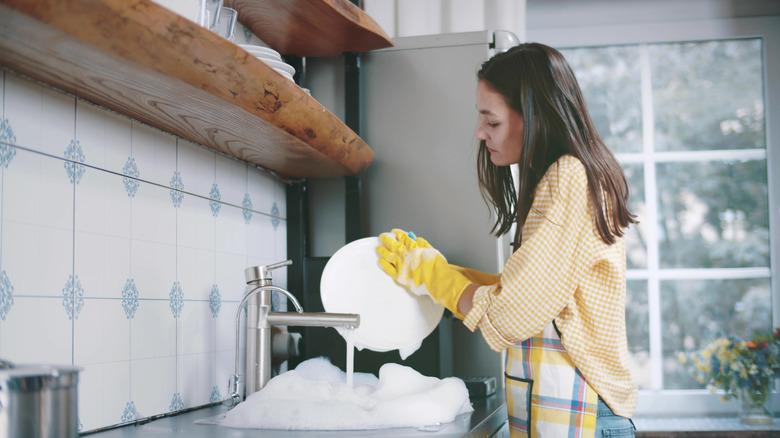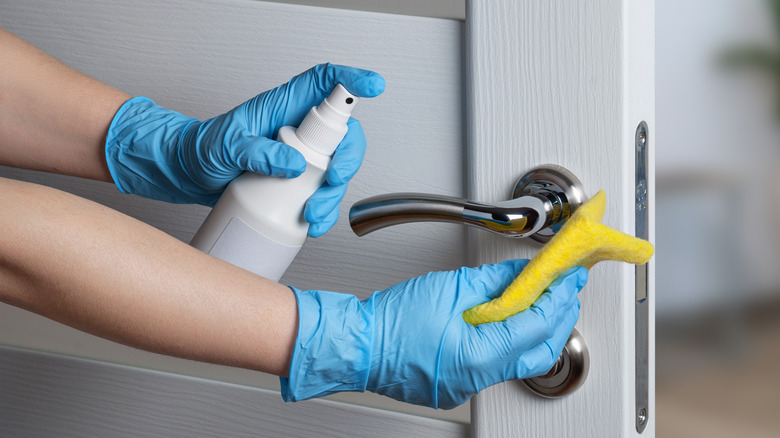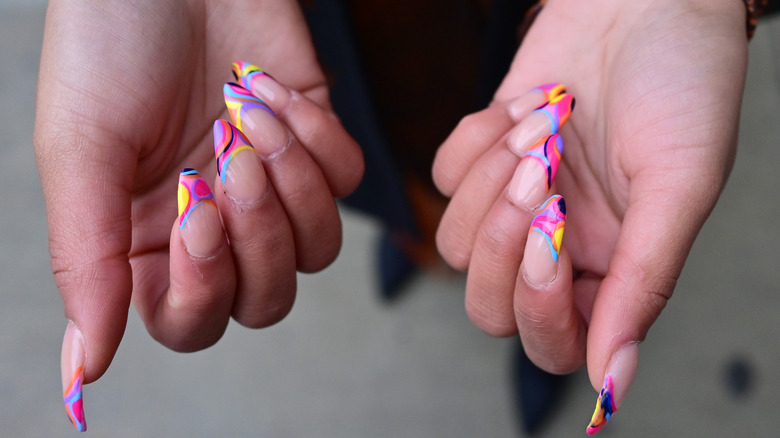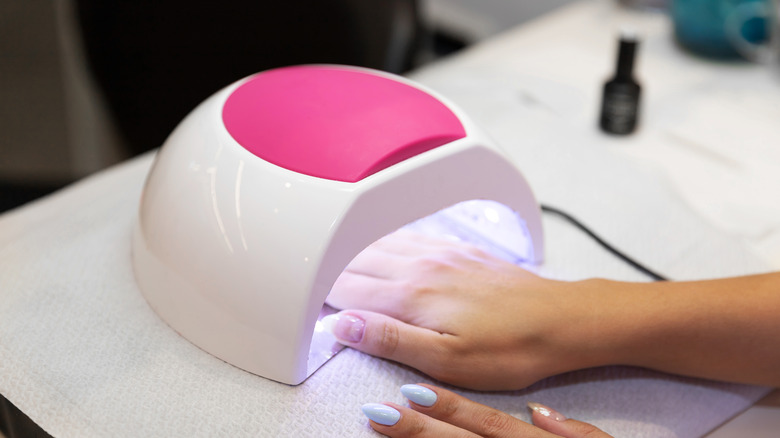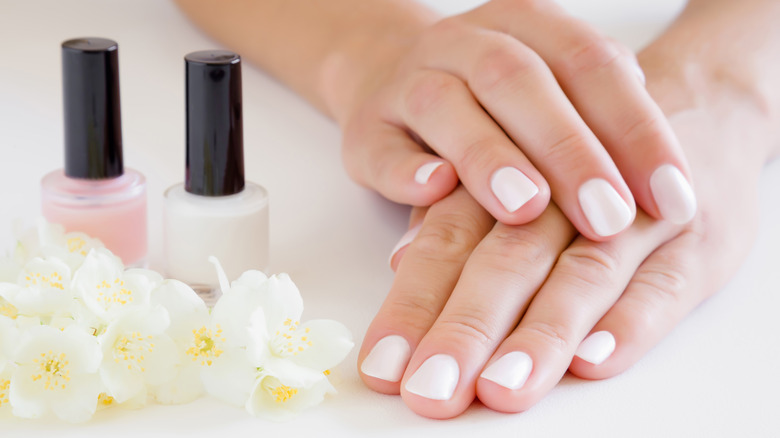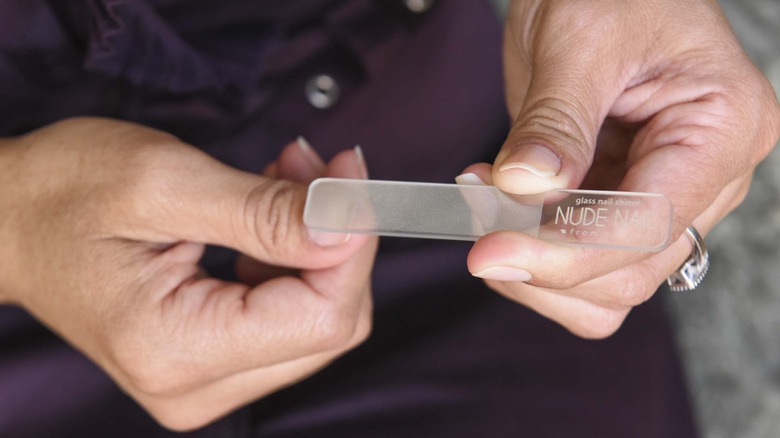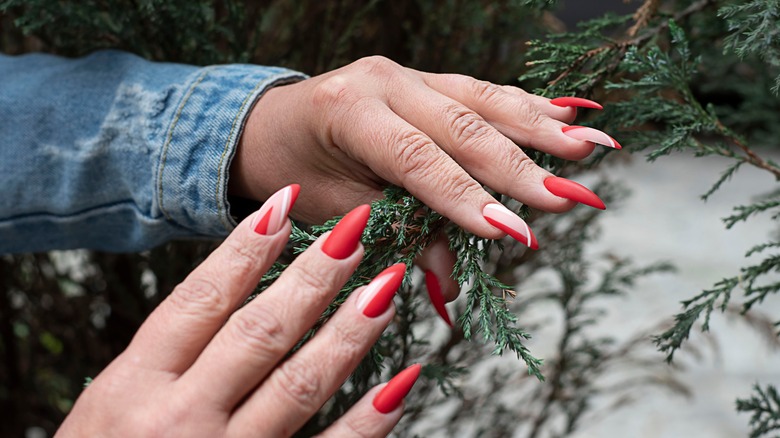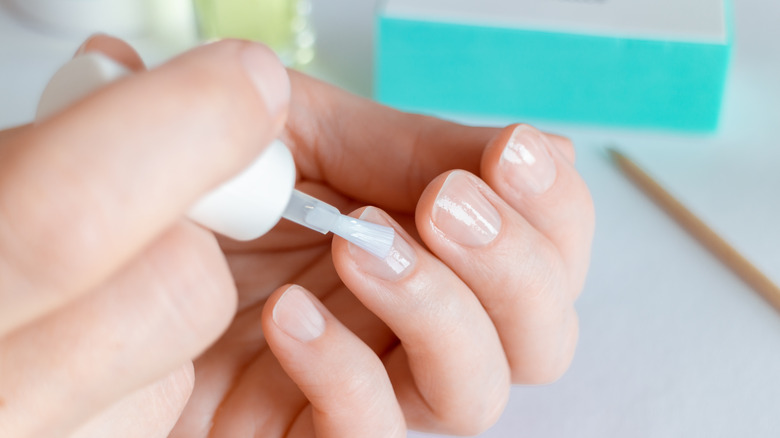Our Top Tips On How To Get Stronger And Healthier Nails
Our fingers are constantly working and, as an extension of them, fingernails put in long hours too. We wash, dry, bump, rip, crack, split, and sometimes even downright abuse them on the daily. With all that work, many of us struggle with keeping our fingernails healthy, strong, and looking good. So it's no wonder that our fingernails need a little TLC every now and then.
According to Mayo Clinic, our nails are built up of layers and layers of keratin, a protein that gets laminated together into sheets by our body to grow out of each finger. Healthy fingernails are smooth, without any pits or ridges, have no visible signs of discolored patches, and have an even thickness from cuticle to tip.
Sometimes there are certain changes our nails undergo that shouldn't raise any kind of red flags. For example, as you age, you might develop harmless vertical ridges on your nails (via Harvard Health Publishing). However, signs of distress to your nails that you should be aware of and address include changes in color or shape, thinning or thickening of your nails, separation of your nails from the skin, bleeding, swelling, and pain. You can check in with your doctor to see if any of these issues might be underlying symptoms of something bigger. But until you get to that appointment, there are a few things you can do at home to strengthen your nails and keep them healthy.
Eat a balanced diet
Ah, the old food-as-medicine remedy. It's a well-known fact that what you eat affects your body, and that includes your nails. Because they are mostly made up of protein, it's essential to consume protein in the proper amounts as a part of your diet daily. Dave Crisalli, founder and CEO of PROSE nail boutiques, told Food Network that even those with aversions to meat sources of protein can eat quinoa and nuts to get their recommended dietary allowance of 0.8 grams per kilogram (via Harvard Health Publishing).
Crisalli also praises yellow and orange veggies, such as sweet potatoes and pumpkins, for their high vitamin A content which keeps nails from drying out (via Food Network). Other good additions to your diet to keep your nails healthy are dark, leafy greens. The iron, antioxidants, and calcium found in them will boost the health of your nails and keep them supple, according to Mazz Hanna, celebrity manicurist and founder and CEO of Mazz Hanna High-Vibration Luxury Skincare (via Food Network).
To round out your diet, include omega-3 fatty acids and bone broth, both of which are packed with nutrients. Bone broth is high in collagen, an essential protein for your hair, skin, and nails. "Collagen has really made a difference in the health of my nails. They feel resilient and stronger," celebrity manicurist Geraldine Holford told InStyle. And consuming omega-3 fatty acids, found in salmon, tuna, and walnuts, will keep nails from becoming brittle (via Healthline).
Take a supplement
If you know that your diet isn't quite what it should be and you're lacking in nutrients, supplement with a complete daily vitamin and possibly even minerals or vitamins specific to nail health. Two of the best supplements for nails are biotin and collagen. Biotin is a water-soluble B vitamin, so it is not stored in our bodies and must be taken daily, per Healthline.
Biotin has been shown to support the thickness and firmness of nails, backed up by several studies with one, published in the clinical journal Cutis, finding that biotin increases the thickness of nails by 25%, as reported by the National Library of Medicine. Biotin can be found in foods like sardines, cooked eggs, and legumes (via Healthline) but a supplement will likely have a higher percentage than what you can get from food.
Collagen can also be a good supplement to your daily diet to help support your nails. A clinical trial published in the Journal of Cosmetic Dermatology found collagen supplements to improve the appearance of nails, reduce breakage, and induce faster growth. Ingestible collagen peptides have become incredibly easy to find on the market and come in all kinds of flavors which makes them super easy to add to your routine.
Stay hydrated
Just like the rest of our body needs water, our fingernails also benefit from staying well hydrated. According to Healthline, without adequate water, our nails can become brittle and dry and will crack more easily. Since our nails are one keratin sheet on top of another, they can also split and peel without the moisture needed to keep them "glued" to each other.
According to Arlington Dermatology, about 18% of our nails are comprised of water. This means that a decrease in the amount of water you take in will show, over time, prominently on your nails, because the body will send the hydration to higher-priority functions.
Changing seasons also play a role. During the summer months, you can become more easily dehydrated due to sweating, so upping your water intake is crucial. And during the winter, when we cozy up in our heated homes or offices, the dry heat can suck moisture from skin and nails. While you may not feel like you're as thirsty in cooler weather, it's important to remind yourself to stay hydrated.
Leave nails natural
While keeping our fingertips in line with our favorite nail trends may be top of the to-do list for most of us, giving nails a break from polish, acrylics, and dip powders can help keep them healthier in the long run. "Not only are acrylic and dip powder nails full of potentially nail-harming ingredients, but the process and wear can be very damaging to your nailbeds, and if done improperly can even lead to infection," organic manicurist Eunice Montes-Hamaguchi told MindBodyGreen.
Even just constantly using nail polish, even non-toxic varieties, will keep your nails from breathing properly (per Healthline). To give them a break, remove your nail polish after a week of wear with acetone-free polish remover and leave your nails au naturel for a week to give them time to recuperate.
Celebrity manicurists tell InStyle that they notice when clients leave their nails natural for a few days after removing gels, acrylics, or dip powders. "... anecdotally I can tell you that we totally notice a difference in the strength and health of the nails when our clients do take a break," said Sarah Gibson Tuttle, founder and CEO of Olive & June. Using a base strengthener or polish with nail-building components is a good alternative if you must wear something.
Trim nails short
We've all had it happen – the dreaded moment of catching your nail edge on something. In addition to potentially running your entire manicure, it also leaves behind an annoying bit of nail that just drives you crazy. It's not fun. But it might also be quite harmful to your nails overall. Exposing your nails to constant trauma like that will weaken them and will lead to an endless cycle of breakage and progressive frailty, Sarah Gibson Tuttle, founder and CEO of Olive & June, told InStyle.
Keeping them trimmed short will ensure that your nails stay free of — or at least be less prone to — breakage. We know keeping nails short is not everyone's favorite look, but if your nails have been particularly traumatized recently, consider keeping them short at least for a while (per Healthline). It will give them time to regain their strength without the constant need to heal some part that's been damaged.
Keeping your nails short will also help you keep them clean. The Centers for Disease Control and Prevention (CDC) recommends keeping your nails short to ensure that you easily recognize when dirt or grime has become stuck under them and thus know to clean your nails promptly. Maintaining long nails can make it that much harder to clean the undersides of them, which can lead to the spreading of infections such as pinworms (per the CDC).
Limit water exposure
While hydrating your nails from the inside is advisable, keeping them soaked in water is not. Dr. Dana Stern, assistant clinical professor of dermatology at Mount Sinai and renowned nail expert, tells Well+Good that the nail is 1,000 more absorbent than our skin! Unfortunately, that means that your nails act like sponges, soaking up water anytime they come into contact with it.
While it might seem like a good thing to keep them hydrated, when too much water enters the nail cells, they expand rapidly and then contract as the water is absorbed into the body (per Well+Good). Repeating this over and over again, and expanding the cells to their maximum, strains the nail as a whole and leads to breakage, peeling, and cracking.
Healthline suggests limiting your exposure to water by wearing gloves when you're washing dishes and even trying to keep your hands out of the bath when taking one. During summer days when pool time and lake dips are frequent, make sure to use moisturizers that will prevent the peeling and cracking of your nails such as shea or cocoa butter (via Well+Good).
Avoid harsh products
We now know that our nails are great at soaking up water. So think about this: cleaners, shampoos, and hand sanitizers usually have water as their first ingredient. Ipso facto, when our nails are exposed to these kinds of products, they will usually suck them right in (via Healthline). Do you want your nails bathing in all of those chemicals?
Hand sanitizer, for instance, is very drying to our nails due to the high content of alcohol. It's a good idea to try not to get hand sanitizer on your nails when you use it or follow up with a moisturizer. Most home cleaning products also contain alcohol, water, or other potentially damaging chemicals to your nails so always wear gloves when cleaning around the house.
Other products are harder to avoid getting on your nails, such as shampoo, but there are still a few things you can do. If your nails are dry and brittle and you've been avoiding other products, try switching out your shampoo to one with moisturizers to see if it makes a difference (per Healthline).
Reconsider gel or acrylic nails
One of the biggest culprits of damaged nails is faux nails, including gel, dipped, and acrylic nails. These treatments might give you highly coveted fashionable nails but they're also sabotaging your nail health when you invest in them regularly.
Having gel or acrylic nails can also lead many to pick at their nails, which is probably one of the worst things you can do. "The immediate effects are harming the nail plate because you're removing the top layers of the actual nail along with your polish," celebrity manicurist Geraldine Holford told InStyle. "The long-term effects are thinning of the nails, harm to the nail bed, and irregularities on the nail plate and in growth patterns." If you just can't go without your acrylics, make sure that you're at least following the proper steps for removing them.
Hydrating your nails in between treatments is also a good way to keep them in top form since gel and acrylic treatments make your natural nail dry, brittle, and fragile, according to manicurist Jin Soon Choi, founder of JINsoon nail polish and salons (via InStyle). She recommends applying jojoba oil to your cuticles three times per day for five days for the best results.
Avoid UV light
The use of ultraviolet light (UV) lamps goes hand in hand with gel and acrylic manicures because the polishes contain molecules that need either a UV light or LED lamp to set them, according to a study in the International Journal of Women's Dermatology (via ScienceDirect). Unfortunately, repeated uses of UV treatments on the nails have now been associated with a few different complications. One of which is Pterygium inversum unguis, or the adherence of the skin underneath the nail to the nail plate itself. This can cause pain, especially when cutting or filing nails.
At-home UV light treatments pose even more risk of overexposure than those done by a professional at a salon. A 2016 study published in the journal Contact Dermatitis found that most of the participants who developed side effects from at-home UV nail treatments had pruritic periungual eczematous dermatitis, which is intense dryness and itching around the nail (per Wiley Online Library).
Our nails can also experience sun damage just like our skin can and can become yellowed, brittle, and dry, according to MindBodyGreen. To avoid sun damage on your hands when you are going to be in the sun for an extended period of time, consider applying opaque nail polish to physically block the sun's rays or use a UV filter polish that's able to absorb the rays.
Switch to non-toxic nail products
You might have your favorite nail polish color from your favorite brand, but are you sure that it's not doing your nails more harm than good? It might look nice, but what's lurking under the surface in its chemical composition? Our nails can be allergic and have reactions to chemicals just like the rest of our bodies.
Even if your nails aren't reacting right away, constantly applying harmful chemicals to your nails is not going to be great for them. The U.S. Food & Drug Administration (FDA) warns that potentially harmful chemicals include toluene, phthalates, and formaldehyde. Acrylic nail polishes can also contain methacrylates which can lead to redness, irritation, and swelling and is especially irritating for those that are already sensitive or are prone to other allergic reactions. Keeping your nails away from these chemicals will ensure that they stay healthy and can continue to thrive.
File correctly
Filling your nails regularly will keep them healthy and make sure that you have less splitting. The best way to file your nails is in just one direction (via Heathline). Using a saw-like motion will actually weaken your nails and encourage them to crack. Always pick a good file that will do the job properly. Glass files are often recommended because they are easy to clean and will be more gentle on your nails than emery boards, according to Healthline. A file with a high grit number is also preferable (via MindBodyGreen).
The length of your nails dictates how you should file them, according to Healthline. Both long and short nails should be filed slowly to avoid taking off too much and to achieve your desired shape. Your nail bed will determine the type of shape your nails can take naturally. File long nails by starting from one of the outside corners and moving toward the center. When you've reached the desired length and shape on one side, file from the opposite corner toward the center to get the same size and shape. To file short nails, start on the outside corner and file toward the middle, then do the opposite corner.
Don't use your nails as tools
Dermatologist Dr. Debra Jaliman, assistant professor of dermatology at Icahn School of Medicine at Mount Sinai, tells Popsugar that one of the four main causes for nail peeling is that we use our nails as tools. It sure is tempting though, isn't it? Especially when they're long and it's convenient to do so, such as when peeling off stickers or popping open soda cans. But constantly using your nails to pry open or pick at things, or even using them for reaching and pulling things towards you is going to weaken them and can even cause them to snap, crack, peel, and split.
Dr. Jaliman suggests using other tools for your peeling or picking needs. For example, using a paper clip to reach something stuck in a tight place or using the pad of your fingers to open up a soda can (via Healthline).
Use a nail strengthener
We all need a little help now and then so if your nails are showing signs of weakening and you just want to speed up the healing process a little, invest in a nail strengthener. These products are sometimes advertised as nail serums or base coats, according to MindBodyGreen.
If you're going to be doubling down on strengthening your nails, make sure that you're not adding extra toxins by checking to make sure the product you purchase doesn't include formaldehyde. Instead, opt for natural-leaning nail strengtheners that use vitamin E, olive, oil, garlic, or tea tree (per MindBodyGreen).
Some of the best nail strengtheners on the market include: OPI's Nail Envy, which although one of the priciest options, is very effective at strengthening; the Essie All-In-One, which is wonderful to use as a base coat, top coat, or just as a treatment; and the ONYX Professional Hard as Hoof Nail Strengthening Cream, a proven formula for over 20 years that will help strengthen your nails and soften your cuticles as well as prevent chips.
